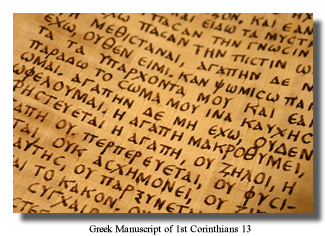
We have spent some time here and there discussing the issue of translations. Which one's are best? Why are there so many? Etc. The following is a helpful chart that helps explain some of the issues raised with the various translations. It is broken up into three categories: Word-for-Word, Thought-for-Thought, and Paraphrase.
Word-for-Word translations begin with the original languages (Hebrew in the Old Testament and Greek in the New Testament) and seek to give a word-for-word translation of the text. Therefore, the Hebrew/Greek word son is translated son, and so forth. There are a lot of advantages of this. One, the attempt of the translators is to present the Biblical text as-is without any interpretation on the part of the editors and translators. The main problem with this is oftentimes readability. There is a huge cultural gap between the ancient near east during Moses day and our day. Also, issues like translating monetary words like denarii are lost in today's culture.
Thought-for-Thought translations look at the original language and try to word it in the way that is more readable and understandable to the reader while trying to grasp the meaning of the text. This means that if one looked at the original languages and then compared it to a Thought-for-Thought translation, they will not be very similar. However, upon closer review, the two will essentially be saying the same thing. The advantage of this approach is readability. It avoids some of the odd language in Word-for-Word translations. The problem, however, is that it only gives the idea of the text, not the actual text.
Finally, Paraphrases are simply paraphrases of the text. The editors do not seek to capture the actual wording of the original or even the main thrust of the passage. Rather is is a much easy read that seeks to give the reader the basic point of the passage. The advantage of these is the simplicity of the readability. The problem, however, is how drastically different they oftentimes are from the original language which threatens to loose the original message of the text.
My preference is Word-for-Word. I want to know what the text actually says, not what the translators think it says. I am not saying that the others are useless and bad (although I am not a fan of paraphrases), but that Word-for-Word translations best represent the text as God wrote it.
Here is the chart:
 The chart above, and I think their right, considers the New American Standard (NASB) to be the most accurate translation. It is my favorite translation for that purpose. On Sunday mornings, I used the New King James Version (NKJV) not because it is my favorite, though it is a good one, but because the King James Version (KJV) is so prevalent and common in the Bible belt. The NKJV is similar to the KJV minus the thees and thous.
The chart above, and I think their right, considers the New American Standard (NASB) to be the most accurate translation. It is my favorite translation for that purpose. On Sunday mornings, I used the New King James Version (NKJV) not because it is my favorite, though it is a good one, but because the King James Version (KJV) is so prevalent and common in the Bible belt. The NKJV is similar to the KJV minus the thees and thous.
What translation do you use and why?
For More:
Defending, Contending - Bible translation comparison chart.
Translations and the Subjugation of Women: Emergents Make a Stretch
Zondervan - Biblica Announces First Update in Quarter Century of the World’s Most Popular Bible
Baptist Press - NIV to be revised in 2011; TNIV to be discontinued
"On the Seventh Day the Lord chillaxed" - Conan on the NIV Translation
King James Only?
John MacArthur and the Authority of Scripture
Sola Emergent: The Emerging Church and Revelation - Part 1
Sola Emergent: The Emerging Church and Revelation - Scripture is Reaction Part 2
The Bible in One Minute or Less
"The Blue Parakeet"
"God's Secretaries"
Mohler on the Archaeological Study Bible
"3:16: The Numbers of Hope"
 We have spent some time here and there discussing the issue of translations. Which one's are best? Why are there so many? Etc. The following is a helpful chart that helps explain some of the issues raised with the various translations. It is broken up into three categories: Word-for-Word, Thought-for-Thought, and Paraphrase.
We have spent some time here and there discussing the issue of translations. Which one's are best? Why are there so many? Etc. The following is a helpful chart that helps explain some of the issues raised with the various translations. It is broken up into three categories: Word-for-Word, Thought-for-Thought, and Paraphrase. The chart above, and I think their right, considers the New American Standard (NASB) to be the most accurate translation. It is my favorite translation for that purpose. On Sunday mornings, I used the New King James Version (NKJV) not because it is my favorite, though it is a good one, but because the King James Version (KJV) is so prevalent and common in the Bible belt. The NKJV is similar to the KJV minus the thees and thous.
The chart above, and I think their right, considers the New American Standard (NASB) to be the most accurate translation. It is my favorite translation for that purpose. On Sunday mornings, I used the New King James Version (NKJV) not because it is my favorite, though it is a good one, but because the King James Version (KJV) is so prevalent and common in the Bible belt. The NKJV is similar to the KJV minus the thees and thous.



No comments:
Post a Comment